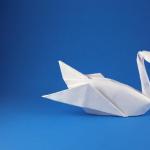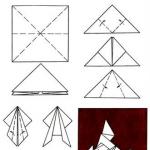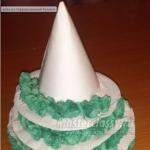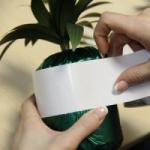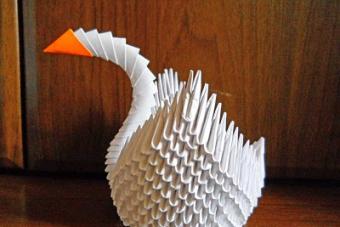A year ago, I received an order - to sew a development book. I thought for a while (I had never sewed books!), But agreed - it was interesting to try. And Olga, the customer, made me another offer, which I couldn’t refuse :) She suggested publishing in the Scrap-Info magazine a story about how the book was created - with details, tips and illustrations.
The article was published in the 6th, December issue of the magazine last year. This issue was devoted to the synthesis of scrapbooking and other needlework and it turned out to be very interesting! On the pages of the magazine I met a lot of familiar faces and names :) According to the editorial staff for the time being, I did not have the right to publish the story on my blog. But now it’s already possible :)
How I sewed a development book: from an idea to an embodiment
I dreamed of stitching a soft developmental book for a long time. She admired the creations of other craftswomen, collected ideas, studied master classes. But somehow it did not work out - either there was no time, then the complexity and painstaking work frightened. And once I received an order from Olya for sewing a crocodile and pigs for a bottle. In addition, Olga asked if I would undertake to sew a developmental book for her daughter. I hesitated a little, and then agreed - when, if not now?
I must say right away that this work turned out to be quite complicated and lengthy for me, but interesting and fascinating.
Stage 1. Tasks and ideas
Taking into account Olya’s wishes, I decided that the book will include various game elements for the development of fine motor skills, materials of different textures will be used for a variety of tactile sensations, in addition, as the child grows up, with the help of the book, the baby can learn the basic colors and count from one to ten.
Thus, it turned out that the book should consist of ten turns. Each of them should be one of the colors of the rainbow plus “black”, “white” and “rainbow” turns. In addition, each U-turn will be dedicated to any one digit - from one to ten. This means that the figure itself must be displayed there and the tasks related to the score, as well as finger training, should be contained.
And the book should have a cover. On the front cover, I decided to make the little girl’s face a little like my little mistress, and write her name, and sew a pocket on the back, where you can put removable parts so that they are not lost.
In her favorite "ideological" album, she began to sketch out the pages.
Then it turned out that collecting other people's ideas is both useful and harmful. The first thing that came to mind was the idea that everyone knows and is widely used - a ladybug with moving wings and legs, a snail with a bead inside, a baby face, etc. But it was painful that some of them fit well into the concept of the book, so I suffered a bit of remorse, but still decided to use them, comforting myself with the fact that, firstly, I would still slightly change these ideas to fit my idea, into secondly, the book itself will be more complex and multifunctional, and, thirdly, my personal ideas will also be in it. For example, the idea of \u200b\u200bturning on / off the lights in night houses. Honestly, I have not spied her anywhere! :)
The longest time I fussed around was an orange U-turn with the number 4. I couldn’t manage to match the color, number and plot. But in the end, the four red squirrels playing hide and seek on the autumn tree were tortured :)
By the way, at first I generally tried to connect a number series with a color sequence: 1 - red, 2 - orange, etc. about hunters and pheasants and one-two-three-four-five, but this turned out to be an impossible task for me, so I decided to leave this thought behind.
Stage 2. "White" sketches and thought over details
At the very beginning, Olya and I discussed the size of the book and how to connect the pages to each other. After draft sketches, I proceeded to life-size sketches, while thinking over and writing down which fabrics of which texture and what accessories will be used, what should be movable in the book, and what is sewn tight so that little pens cannot tear anything, what parts to make removable what tasks should contain pages, etc.
Stage 3. Selection of materials from personal stocks
The easiest and most interesting stage. I love to delve into rags, ribbons and buttons! Threw out all its stocks of fabrics, ribbons, beads, accessories. Sifted through, picked up, applied and caught the buzz, while recording what needs to be bought in order to carry out the plan. Despite the fact that I have considerable reserves, the list of everything necessary turned out to be impressive.
Stage 4. Materials purchase
With this impressive list, I went shopping. Naturally, it did not manage with one call. It’s one thing to come up with, and another thing to acquire exactly what you need. Therefore, I had to abandon several ideas, change something, but there were also some inspirations - for example, when I met rainbow buttons, the idea of \u200b\u200ba multi-colored caterpillar from circles fastening on these buttons came up immediately, velvet came in the best way for a black-night picture ("Velvet night", however), etc.
Stage 5. Patterns and patterns
Having drawn the life-size plots of the book, I translated it into tracing paper and cut out all the necessary details that needed to be cut out for applications and removable parts. For the numbers and letters on the cover, I picked up the font, enlarged it to the desired size, printed it on plain paper and cut it out - we got stencils.
Stage 6. Cut
I began with the pages of the book: I cut out squares taking into account allowances for seams from the main fabrics, as well as squares of the same size from thin and voluminous non-woven fabric.
I cut all the squares in one fell swoop - it’s faster and more convenient for me. When cutting, I used a special ruler and a rug for a patchwork and a circular knife. I don’t understand how I did without them before.
According to the prepared patterns-stencils, I carved out all the necessary details for applications and volumetric details. Here the reception didn’t work in one fell swoop - I cut out a game for each plot separately, or I would have got confused - there are too many small details. The contours were transferred to the fabric using a special felt-tip pen - the lines from it disappear on their own within a few hours or immediately after the fabric is slightly moistened. When working with small parts, applications, this tool is simply irreplaceable!
By the way, I initially transferred the contours to thin non-woven fabric, then cut and pasted onto the desired fabric and cut it out again, having already completely prepared the part for sewing. I cut all the details with scissors - a painstaking, long and dreary occupation, I must tell you, taking into account the double work.
Stage 7. Sewing
Each square page was first glued with a thin non-woven, then voluminous. I was still afraid that the pages would turn out too thin and would not keep their shape, so I decided to seal some pages with a thin ironed padding polyester, as a result - I went too far, the pages turned out to be too thick, which affected the thickness of the book itself, and I had to tinker with installing eyelets. Small details, as I said, were also all glued with a thin non-woven.
Then the fun began - actually sewing. First, I sewed layer by layer, after joking with large pins to the base, and catching small details that served as a background (grass, wood, snow from lace, etc.), as well as the main details (snails, ladybug, squirrels, elephant, numbers ), simultaneously sewing in voluminous and moving parts (bush, grass blades of ribbon, wings, legs and horns), some of which had to be previously separately sewn, decorated and filled with beads (wings of a ladybug, pocket waves, elephant’s ear, etc. .).
Usually I sew appliqués along the contour with a thick zigzag stitch - it seems to me neater and more reliable. I sewed some small details from felt with a usual line.
In the process of sewing, of course, we had to constantly iron the parts and details, seams and seams so that the final picture looked neat.
Then I started sewing removable parts.
Stage 8. Handwork
A lot of sewing books turned out to be handmade. Sewing numerous buttons, buttons, installing eyelets, embroidering mouth-eyes and even crocheting “apples”.
Initially, I planned to sew apples from felt, but they were very small, I was too lazy and I was immediately visited by the happy idea of \u200b\u200btying wooden beads with cotton threads. Volume and new tactile sensations from touching a knitted surface! One BUT, but very important! The apples are very small and the child should carry out all manipulations with them under the vigilant supervision of mom-dad. I tried to sew all the other parts tightly, especially buttons.
Stage 9th. Assembly
Phew! Finally, all the pages are ready! Now you need to start stitching pages into sheets and connecting the sheets together. The work is no longer creative, but rather technical. Having laid out the squares in order, with the front sides inward, I laid a line around the perimeter, leaving a hole through which I then turned the pages.
To get even corners, from the wrong side I cut the corners obliquely close to the line.
Turning it over, steamed the pages, I did not begin to sew up the hole with a hidden seam, but sewed it on top only on one side of the square, the one where the “hole” was.
Then she put the grommets, as I said, "with a sin in half" because of the thickness of some pages, and connected all the sheets with a cord.
During the initial discussion of the book, Olya and I said that they could be connected by rings. But, firstly, the book turned out to be too thick, such large rings were still not on sale, and, secondly, even if such a diameter were found, they are all detachable and I would be afraid that the baby might pinch her fingers.
For the future, she noted for herself - to seal one sheet of a book, it is enough to use thin non-woven for each page plus between them - one layer of volume non-woven or thin synthetic winterizer. Instead of eyelets, loops can be sewn into each sheet and then all the sheets can also be connected with a cord. I like the connection with the help of the lace because the pages of the book can be separated at any time, swapped, played with separate plots, arranged in order of pages with numbers or colored pages in colors.
But will I dare to sew such a book again? Eeeee ... Probably yes! But only after a break :) -
All parents want their kids to develop correctly and on time. If you are trying to independently educate your baby at home, then a soft book made of fabric will become your indispensable assistant in this matter. Of course, you can buy it, but making it yourself is not at all difficult. If you are interested, then stay with us.
What are such soft books for?
The study of literature is very important for a person at any age. Almost every mother dreams of raising a smart, educated and successful child in all areas of life. Therefore, it is very important to teach your kid books as early as possible. These amazing fabric books will cause interest even in the smallest little peanut (from 6 months).

Being engaged only with such a book, you will be able to teach the baby:
1. Distinguish colors, because bright and colorful pages will contribute to this. If the Rainbow page appears in your book, then he will cope with such a task twice as fast.
2. Understand the difference between small and large objects, because the book will be full of details of different sizes.
3. To develop fine motor skills of fingers thanks to tactile sensations and thus further contribute to the rapid development of speech.

4. They will help little fingers cope fasterwith different fasteners, clasps, cords and rivets.
5. Learn letters, numbers and geometric shapes. The kid learns to count to ten and solve the simplest logic puzzles. And thanks to stitched letters, it can easily add up its own name or another word.
6. Gets some skills necessary in everyday life: to tie shoelaces on boots, to weave braids in hair and so on.

7. Develops visual perception, attention and thinking.
8. You can also introduce the baby to the seasons, insects, animals, marine life, visit a farm, study the time, and also learn many other exciting and interesting things.

Important! The book should be made only to your taste. It can be made with any material of different sizes and designs. Ideas for creating pages depend on your imagination. All financial costs during the manufacture of it with your own hands will be much cheaper than buying finished material.

What materials are needed to get started?
- multi-colored felt (it is best to take soft for creating volumetric objects and hard for ordinary parts, size from 1 to 3 mm);
- fabric, which will be the basis for the pages and doubler to give them strength;
- multi-colored sewing threads, filler (synthetic winterizer or holofiber) for stuffing parts, pins and needles;
- various ribbons, buttons, beads, rivets, elastic bands, locks, Velcro.
Important points when creating a soft book for children (step by step instructions):
1. First, think up and draw a layout for your future book. Agree how many pages it should have, what storylines will be used and how you will fix it. Pick up patterns (can be found on the Internet by asking for "coloring for children" and print them on a printer).

2. We prepare fabric pages. To do this, take an already prepared cardboard template (a square, for example 20 * 20) and cut neat blanks from doublerin. Fold a piece of fabric face down (pre-steam it with an iron). Place the doublerin squares on it (smooth side down). Preheat the iron to maximum, turn off the steam and smooth the doublerin square on the fabric for 3-4 minutes (they should stick together well). Then carefully cut the finished squares and you get excellent compacted pages.

3. Next, take the felt and according to the plot using patterns, cut and create the necessary elements. Be sure to make movable (on buttons, Velcro, buttons) and immovable parts. Children will be very interested in tearing them off the page and fastening them back. How to make some parts correctly, we will describe in detail below.

4. We sew the finished pages with the application together, forming a three-dimensional page of the book. To do this, we insert a synthetic winterizer between the fabrics of a slightly larger size (1 cm and 0.5 cm thick) than the pages and sew them together. We cut off the excess synthetic winterizer and process the edges with an inlay.


5. And the final stage - the choice of binding options for the booklet. This can be a fabric binding, on grommets, with a hard spine or in another way.

Master class - "Fabric binding"
Page ideas for your future soft book
1. For children from 1 year to 3 years:
- The Labyrinth. To create this page you need to use a grid with large holes (sold in a fabric store), fabric or thermal stickers (to indicate the beginning and end of the maze) and a flat button that will go through the maze.

- "The spider on the web". On a fabric basis, draw a cobweb with a vanishing marker, then scribble it on a typewriter with black thread. The spider is made of black felt and it is attached to the spider web with Velcro. Around the web we fasten the rings and stretch the lace.

- "Ladybug" . It consists of two colors and a lock. Velcro fasten her kids. They can even hide under mom’s wings.


- "Bunny traveler." The balls are attached to the buttons, and easily detachable (you can make any number of them if you wish). The bunny is removable, so a child can play with it like a toy.

- "Animals." Here the child learns what each animal is called and what sounds it makes. Then in the common bowl we have food for everyone and the baby must determine who eats what, fastening it on the appropriate hook.

2. For children 4-5 years old:
- "Clock". Thanks to this page, an adult child can study time. All tsiferki keep on flypapers and removable, arrows turn.

- "Pigtails." The kid trains his fingers by braiding pigtails, and can also fantasize and do different hairstyles for the dog, because the set contains a set of elastic bands. There are also beads that can be changed at your discretion.
Children from one year to three years old are real fidgets. It is difficult to captivate them with something for a long time, they want to touch, touch and taste everything. It is through such interaction with objects that the baby learns the world. You can help your child in this process by stitching development books with his own hands from felt. You will find patterns for their construction in this material.
Everything ingenious is simple: original ideas for sewing
A tactile felt book is a very unusual toy. It will be difficult to break, tear or somehow ruin it. It is quite light, pleasant to the touch, and also very interesting and fascinating. You have probably heard many times about developing children's books, and perhaps even saw them in stores.
Most often they are sewn from soft and dense fabrics using additional accessories: buttons, fasteners, beads, zippers and ribbons. Studying each page of such a book by touch, the kid, without knowing it, develops fine motor skills of fingers and trains sensory perception of the picture. It is due to the variety of decorative elements that the development book is not just a teacher, but also a rather interesting children's game.
In order to sew educational books for children from fabric with your own hands, first of all you will need page patterns. It is worth saying that here you have a lot of options, for example:
- For the little princess on the page of the book, you can depict a bouquet of flowers or a heart with cakes.

- You can cut out all the elements for this applique according to the pattern and attach to the fabric with rivets.

- To create a theme book about the seasons, this page thumbnail is suitable. As in the previous version, the fruits on the branch must be attached with fasteners.

- Another good design example is a dinosaur whose tail and spikes are attached to adhesive tape.

- Try to cut out these flowers according to the pattern and make a small botanical garden on the page.

- Or make a ladybug with a bag on his back. You will find her sketch below.

The choice of the application of a developing book made of felt, made by yourself, largely depends on the basic idea of \u200b\u200bdesign. On its pages you can play the whole performance, where the main characters will be the characters of fairy tales or cartoons.
For a child over two years old, you can come up with educational games for the account, learning the ABC or developing speech. Everything will depend on your own preferences and, of course, imagination.
Read also:
As an example, we offer you a good master class on creating a soft felt book on the topic: “Where do butterflies come from”.
We sew a book for little why-you
Educational books for children with their own hands can be sewn from different fabrics, but as a basis it is always better to take dense felt. But for decor elements it would be nice to use a material of different textures. This technique will help you learn to distinguish the properties of different objects, which is very important in the early development of the child.
For example, you can cut wings for a butterfly from lace, and a body from fleece. You will learn more about how to properly arrange pages of a book and fix details from a photo lesson. If you are ready, then we begin.

Necessary materials:
- pieces of multi-colored felt;
- folder;
- sewing machine;
- scissors;
- tapes;
- fasteners;
- velcro
Process description:
- To get started, cut out the felt pages for a future book. In total, they will need 4 pieces for interior design and 2 - to create a cover.
- The first page will be devoted to the history of the tree and small caterpillars. You can cut all the details according to the following pattern.

- The main part of the tree and green leaves are sewn tightly to the page. To fasten the tracks, we cut out small Velcro fasteners: we fasten one part to the canvas and the other to the part.
- We hide a small chrysalis under a leaf, it is desirable to designate it in a different color.
- In the finished version, the first page will look like this.

- On the second page of the book, we will tell the child what the caterpillars turn into when they grow up. Here we will depict flying butterflies and flowers.

- Sew to the canvas you need only the stem of the flower, the core and green grass. Leave the petals untouched to create a picture as close to reality as possible.
- Sew part of the ribbon to the body of the butterflies, hide the second under the grass. We will leave the moths in free flight so that they can move to the flower and back to the ground.

- The third page of the book will be devoted to creativity. On it, the baby himself must come up with what colors to decorate the butterfly.


- We sew the butterfly to the page only for the middle, and let the wings remain free.

- The fourth last page is a kind of addition to the previous one. On it we sew a large green leaf.

- Do not sew on the top edge of the leaflet so that all decorations for butterfly wings can be placed in it.
- That's all. Bright development book is ready!
An article on how to make a developmental book for a child with their own hands. A description of all the stages of work and all the subtleties that you need to know in order to sew a beautiful baby book.
Touching the objects with their fingers, young children receive information about the world around them. The child learns to understand what is so cold, what is so hot, that objects are sharp, soft, rough, smooth.
Soft and warm things are pleasant to children and it is no coincidence that they rush from morning to evening with soft toys and do not part when they go to sleep. That is why children are very fond of soft cloth books that can be sewn by the parents themselves.

DIY books for kindergarten do-it-yourself felt felt step-by-step instructions
Playing with soft books, children can learn:
- Understand the difference between large and small objects
- Remember what the circle, square, triangle and rectangle are called and what they are called
- Count to ten and solve addition and subtraction problems
- Solve logical problems in which the child determines whether the color and object matches its place
- Learn to tie a bow and weave a pigtail
- Learn letters

In order to make a book of cloth at home you need to stock up
- different felt felt
- fabric that will be the basis for the pages
- suitable sewing threads
- a piece of syntepon
You can calculate the number of materials for sewing, if you decide how many pages will be in your book and what size these pages will be. If the pages are of different colors, you will have to make a calculation for each color separately.

Make a paper template for the length and width of the page of the book. Next, you will need to calculate how many such pages will fit on the width of the fabric that you are going to buy.
Do not forget that since each page will be sewn from two pieces of fabric, then the fabric will need twice as much
Inside the pages, it will be necessary to put a synthetic winterizer and a sealing fabric so that the pages do not crumple and the applications, buttons, buttons and other stripes are firmly held.

DIY soft development book ideas
Next, you will need to figure out what will be on each page of the book. For example, you can make a page where the child will learn what the colors of the rainbow are called. To bring this idea to life, it will turn out by sewing on the fabric multi-colored buttons that match these colors.

If you make numbers in the book with Velcro, then the child will be able to attach them in place and learn the score.

For the math page, make plus, minus, and equal signs. So right in the book you can solve simple examples and tasks. Instead of numbers, for the smallest, sometimes they use figures of animals and insects, fruits and vegetables.

On such a page, the baby will be able to attach multi-colored circles that will match the color of the feathers on the tail of the peacock.

And on this page, strips of the pyramid are attached to the baby book with Velcro, which must be folded from small to large.

Flowers are removed and put on buttons. Under the leaf sits a bug. On this page you can remember what flowers should be worn on the buttons of yellow, red and blue.

Soft puzzle with Velcro on the page of the book. The kid will have to work hard to fold it.

Soft geometric shapes fastened with buttons, on the next page a zipper fastener of all colors of the rainbow.

A developmental book for the smallest do-it-yourself felt felt: step-by-step instructions
To make it easier to sew a book, make sketches for the most difficult pages to sew on paper. Draw animal figures, flowers, geometric shapes. You can use ready-made templates for these purposes. After you come up with an idea and make a sketch - it's time to start sewing pages.

Each page of the book consists of fabric, which will be the face of the page and adhesive fabric of the same size.
- Glue sealing adhesive to the facial tissue with an iron
- From felt cut out figures for applique and small details for figures
- Manually assemble animal figures, flowers, numbers and letters
- Sew all the details on a typewriter
- Pin the finished appliqués to the fabric with pins or attach with a few stitches manually with a needle
- Sew the figures to the page in a zigzag or straight stitch
Video: How to sew felt blanks to a page?
The pages of the book look interesting, where animals seem to be sitting in grass, flowers or on trees.

How to make Velcro applications?
You can sew Velcro right on the felt from the wrong side. But, if you have doubts that in the process of tearing and gluing the figure with the Velcro will not tear, then you can lay a sealing fabric under the felt. Sew a Velcro square onto a dense fabric larger than the appliqué.

- Apply center fabric to the back of the applique in the center.
- Fasten with pins and zigzag sew applique to the wrong fabric
- Then carefully trim the protruding edge of the fabric with scissors.
- Sew together all the details
If the application is small, then Velcro can be sewn not in the center, but along the contour of the part. You can learn in detail how to do this by watching the video. The second soft side of the Velcro is sewn directly to the page of the book.
Video: How to sew Velcro to the details of a development book?
After all the appliqués, buttons, shoelaces and other details are sewn, you can start sewing pages and collecting books. Take the fabric with the sewn appliqués, lay it face down on the table, lay the synthetic winterizer and the second part of the page face up on top.
Now you can manually flash the page around the edge, and then crop the protruding edges of the padding polyester. The edge of the page is trimmed with inlay as shown in the next video.
Video: How to sew a page of a developing soft book?
To collect the pages of the book in binding, a strip of fabric is attached to them. The line goes from the inside, so when you turn the book you can see a neat transition from one page to another. More clearly, the steps of working with binding can be seen in the video below.
Video: how to flash a soft book binding?
When the pages are sewn, it remains to beautifully close the binding with a piece of fabric. It is sewn by hand and then sewn to a book with one line. How to do this is described in detail in the fourth video.
Video: How nice to close the cover of a soft book?
DIY do-it-yourself soft developmental book: patterns
To make out from the fabric the basis for the homemade book in the form of rectangles is surely not difficult. Just decide how long and wide the pages will be and transfer the dimensions to the fabric. Before work, count how many pieces of fabric you need to cut out. They will need twice as many as there will be pages in your book, plus cloth for the cover.
It is more difficult to cut blanks for animal, insect, berry, flower, leaf figures from fabric. You will need to draw sketches on paper, cut them out with scissors and transfer them to the fabric. If you do not know how to draw, ready-made templates for such drawings will come to the rescue.
Advice for those who want to decorate a soft book in a non-standard way - look for drawings in black and white pictures for coloring

Cut your favorite pattern with scissors, and transfer it to the fabric. Eyes, nose, mouth and ears can be decorated with buttons, beads, embroidery or contrasting fabrics.
DIY baby book for kindergarten from fabric
In fact, there are no strict rules and restrictions for parents who want to make a little book for themselves. You can choose a simplified version of the book, where the cover will be separate, and the pages will simply be embedded inside. To sew the page, glue the adhesive sealing fabric to the fabric from which the page will be made from the inside, then wash the applications on it.

Fold the fabric in half with appliqués inward. Sew the page around the perimeter, and leave one side un sewn. Then turn the blank of the page face out and insert a rectangle of padding polyester inside, which will be smaller in width and length than the page by 2 cm.

Note the fourth raw side manually or on a typewriter. The page is ready. Now do the rest of the pages and the cover. The cover for such a book will simply fold in the middle.

Cover length twice as long as pages plus you will need to add an allowance for the volume of subpages. You can find out the size of the allowance if you stack the finished pages in a stack and measure the height of this stack with a ruler.

If you wish, you can fasten page stitches to the cover, or you can not do this because the child may be more interested in disassembling and collecting pages of the book.
How to make a little book with your own hands for school?
For school, children can easily make a book for a baby with their own hands. Of course, all parents want to help their child in this matter. Because they do not cut the paper evenly enough and cut out not very nicely and write a little crookedly.

But, if you yourself do all the work for them, will they be proud of this book? Are you yourself sorting through your child’s drawings of your baby and finding this very book that you made, and not the child, will review its pages with a smile? Therefore, give the author, that is, your child, complete freedom and allow him to cut, glue, write and draw in his own book what he wants.

How to make a book with your own hands out of paper?
A paper book can be glued, stapled with a needle and thread, or stapled together with a stapler. Most often they make standard books in the form of a notebook or an album, but sheets of a fanciful arbitrary shape look more interesting.

If you want to create a baby book of a non-standard shape, it will be most convenient to make pages using a stencil. Cut one sheet of thick paper and copy the rest of it on it. Inside the baby book can be poems, sayings, drawings and applications. Themes for books are sometimes set by the teacher at school, and on free topics it is interesting to write fairy tales and draw illustrations for them yourself.

